Welcome to your ultimate guide to mastering Etsy’s dashboard!
From tracking your latest sales to navigating through product listings and managing orders, this post will walk you through all the essentials.
We’ll also dive into the advanced tools and integrations that can take your shop to the next level, ensuring you’re equipped with everything you need to thrive on Etsy.
Etsy shop manager: A complete guide
Let’s explore the Etsy Shop Manager and different features it provides for an eCommerce business owner.
Etsy dashboard
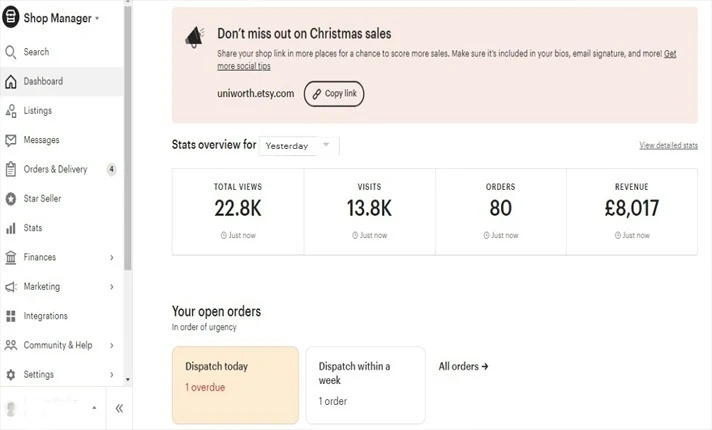
The Etsy dashboard is the landing page that greets you whenever you log into the Etsy account. It’s a compact overview of your store’s pulse.
Here is your most recent sales report for a quick health check. But don’t get distracted, there’s more info to explore!
Search
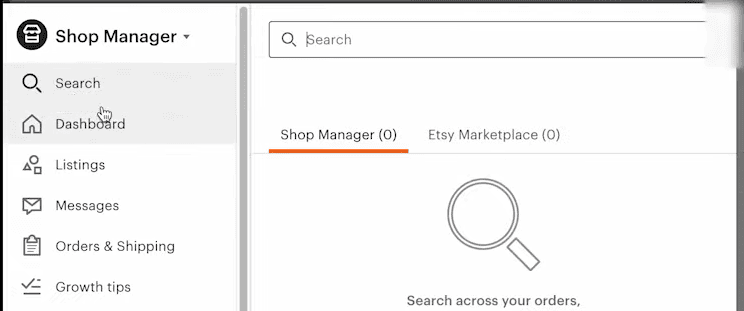
Don’t sleep on Etsy’s search functionality. Sure, it lets you look up orders easily.
But it goes way beyond that with the ability to search through your product descriptions, conversations with buyers, and tons of other areas.
It’s like having your mini search assistant.
Listings
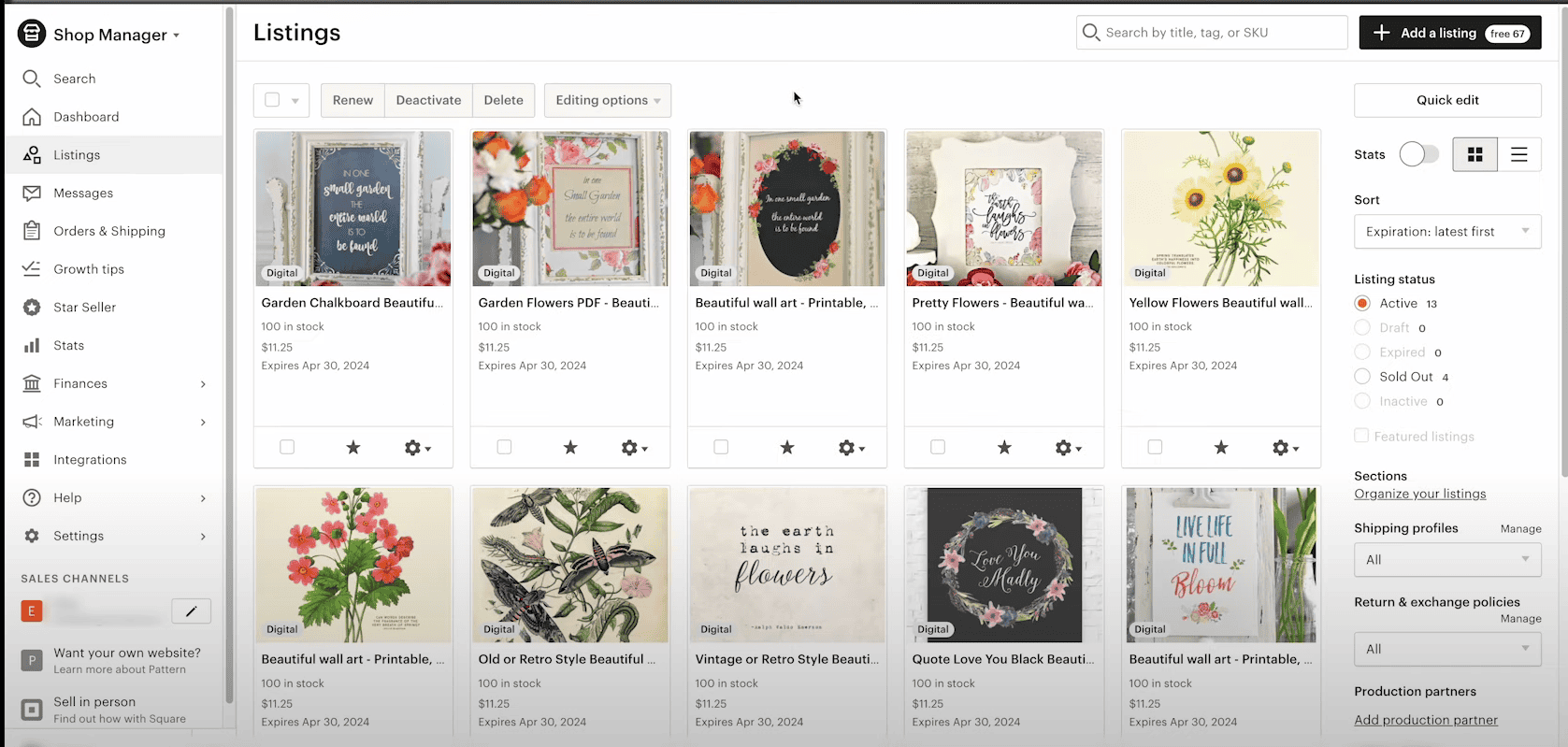
This is the main event in the Etsy dashboard – the listings page is a one-stop shop for all your product offerings. Once you select one or more items, some powerful action buttons appear up top:
- Renew: The clock’s ticking on listings – they expire every 4 months if not sold. Renew puts them back into rotation. There’s even an “Automatic Renew” setting to skip this step.
- Deactivate: Need to pump the brakes on a listing for a bit? Deactivate hides it temporarily.
- Delete: Say goodbye for good. This deletes the listing…but not to worry, it’s reversible!
Beyond those top buttons, there are more settings you can tweak to your heart’s content.
Clicking into a listing pulls up an editing page loaded with details. This is actually the same place you create listings from scratch too when hitting “Add a new listing”.
On the right side, utilize filters like “Expired” to resurface any sleeping listings and renew in bulk.
And then one of the most promising features – the “Stats” button that drops down an analytics report for any listing from the Etsy dashboard.
Messages
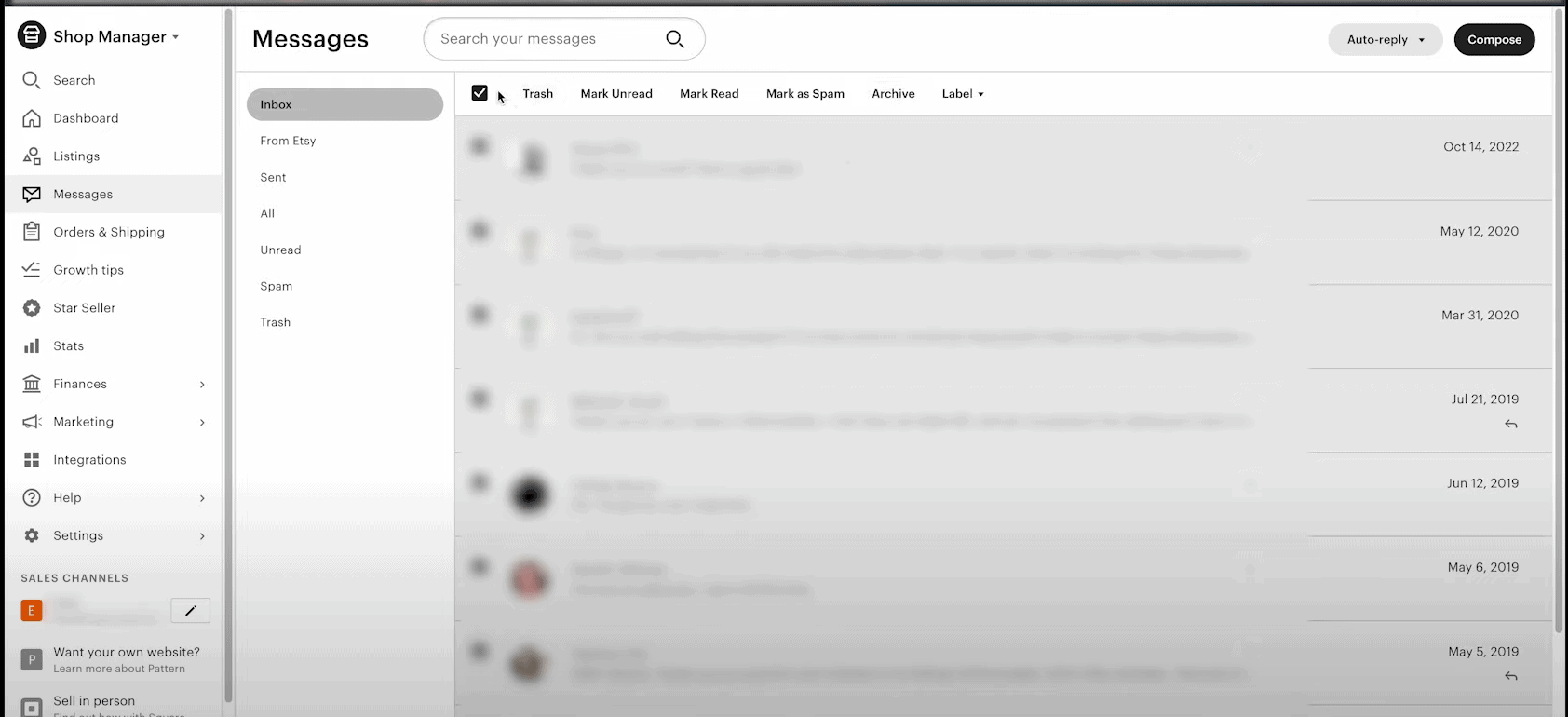
The Etsy Shop Manager also helps you connect with your customers.
This is where you’ll find any questions or comments they have about your listings. But it’s not just an inbox, it’s an opportunity to solidify those buyer relationships.
Any time someone makes a purchase, definitely send a little thank you note their way.
A personal touch like that can go a long way in boosting customer satisfaction and loyalty.
Don’t sleep on those follow-up messages! They can turn one-time buyers into your biggest fans.
Orders & Delivery
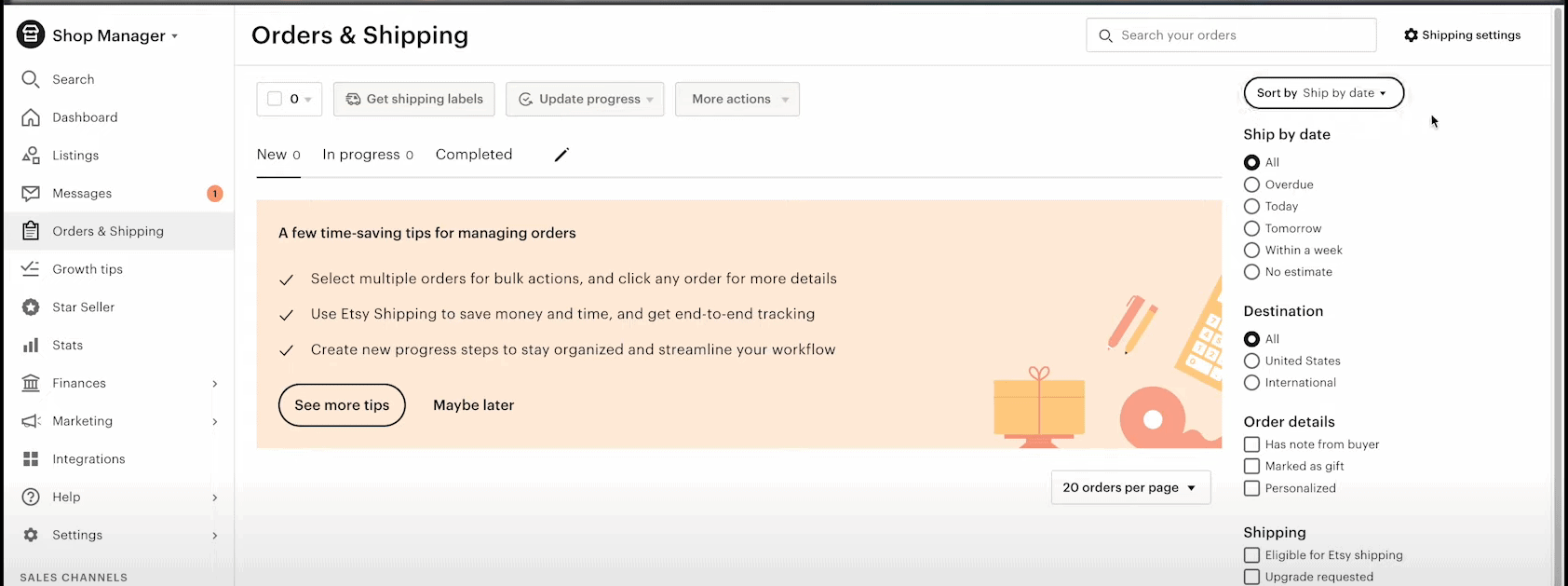
This Etsy dashboard page is command central for order management. Anytime you get that sweet notification of a new sale, this is where all the action happens.
Once you’ve prepped and shipped out an order, simply click on it on this page and mark it as “Completed”.
That’s your cue to notify the buyer that their package is on the way.
It’ll flip the order status to “Completed” on both their end and yours.
Closing out orders properly keeps everything running smoothly for sales tracking and customer communication.
Finances
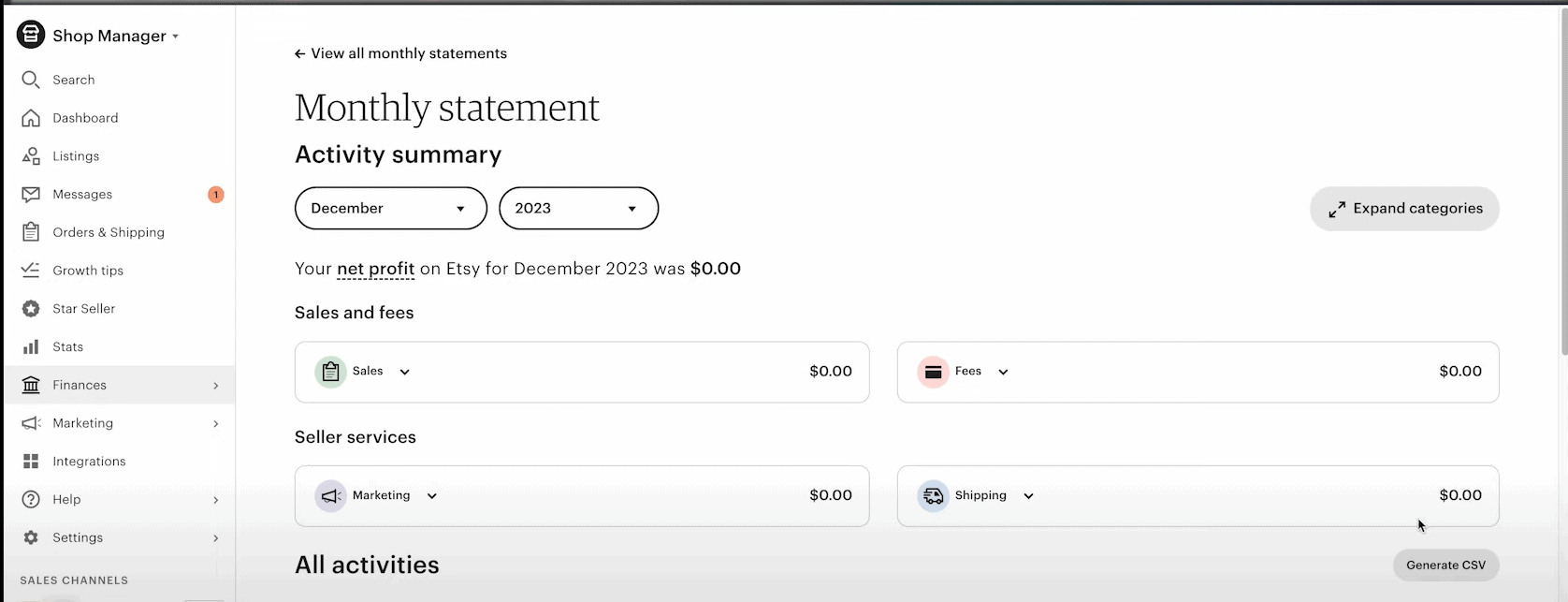
Now, with the Etsy Shop Manager, we’re getting down to brass tacks—the financial nitty-gritty! The Finances section is a tri-part money hub:
Payment accounts
The first one is payment account. Here you can check following things:
- See your projected payout for the upcoming deposit
- Detailed breakdown of each transaction with Etsy’s cut
- Visual graph of your income on one side, expenses on the other
- Customizable date range (the current month is default)
Payment settings
All the core money logistics you set initially are compiled here, and organized into handy tabs:
- Payment Methods for banking details
- Currency locked for your shop’s region
- Billing info for anything Etsy invoices you
- Business address for mail/correspondence
- Setting up tax withholding (don’t skip this one!)
Legal & Tax Info
For most sellers, these pages won’t apply. But key things to note:
- Non-US residents can ignore this
- US sellers must provide tax ID
- German sellers need VAT certificates uploaded
That’s the full financial scope! From money coming in, to money due, to taxable figures – it’s all right here in the Etsy dashboard.
Marketing
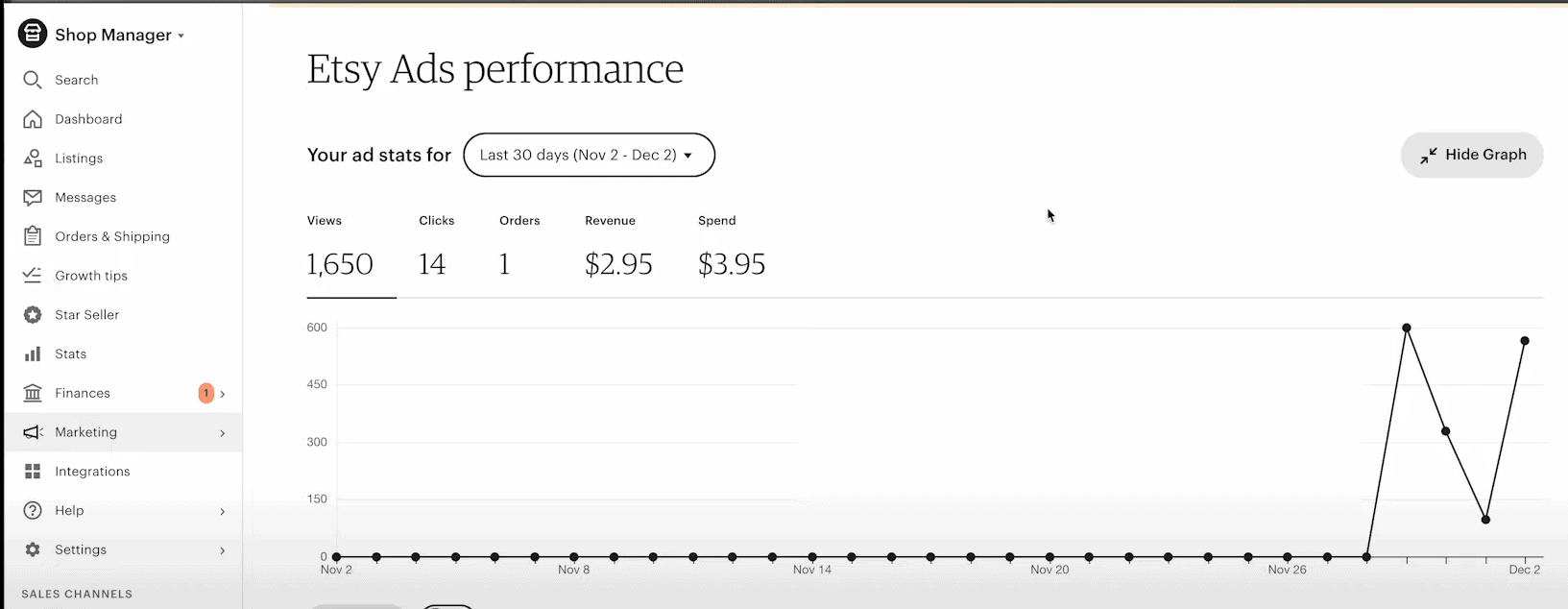
Time to talk marketing and get those products in front of eager shoppers!
The Etsy seller dashboard has some built-in tools to help give your listings a promotional boost.
Search analysis
What better way to optimize than peeking into the actual customer search terms that landed at your store? This new feature breaks down the juicy keyword intel. Up your SEO game!
Sales & Coupons
Run all sorts of promotions and sales straight through Etsy to grab buyers’ attention. You can even create custom coupon codes.
Social Media
Why work harder than you need to? This section lets you easily sync up your store with Facebook, Pinterest, Twitter and Instagram. All you have to do is connect the accounts, and Etsy will hand you ready-to-share listing photos and details.
Integrations
Etsy doesn’t operate alone- it plays nicely with a bunch of other platforms and tools through integrations. The possibilities are endless for streamlining your operations.
For example, there are integrations with accounting software like QuickBooks.
Once connected, your entire transaction history can flow into your accounting system hands-free. No more manual entry or data wrangling!
The integration options in the Etsy shop dashboard are always growing to cover analytics apps, inbox managers, you name it.
Spend less time on redundant admin tasks and more time strategizing sales.
Etsy analytics
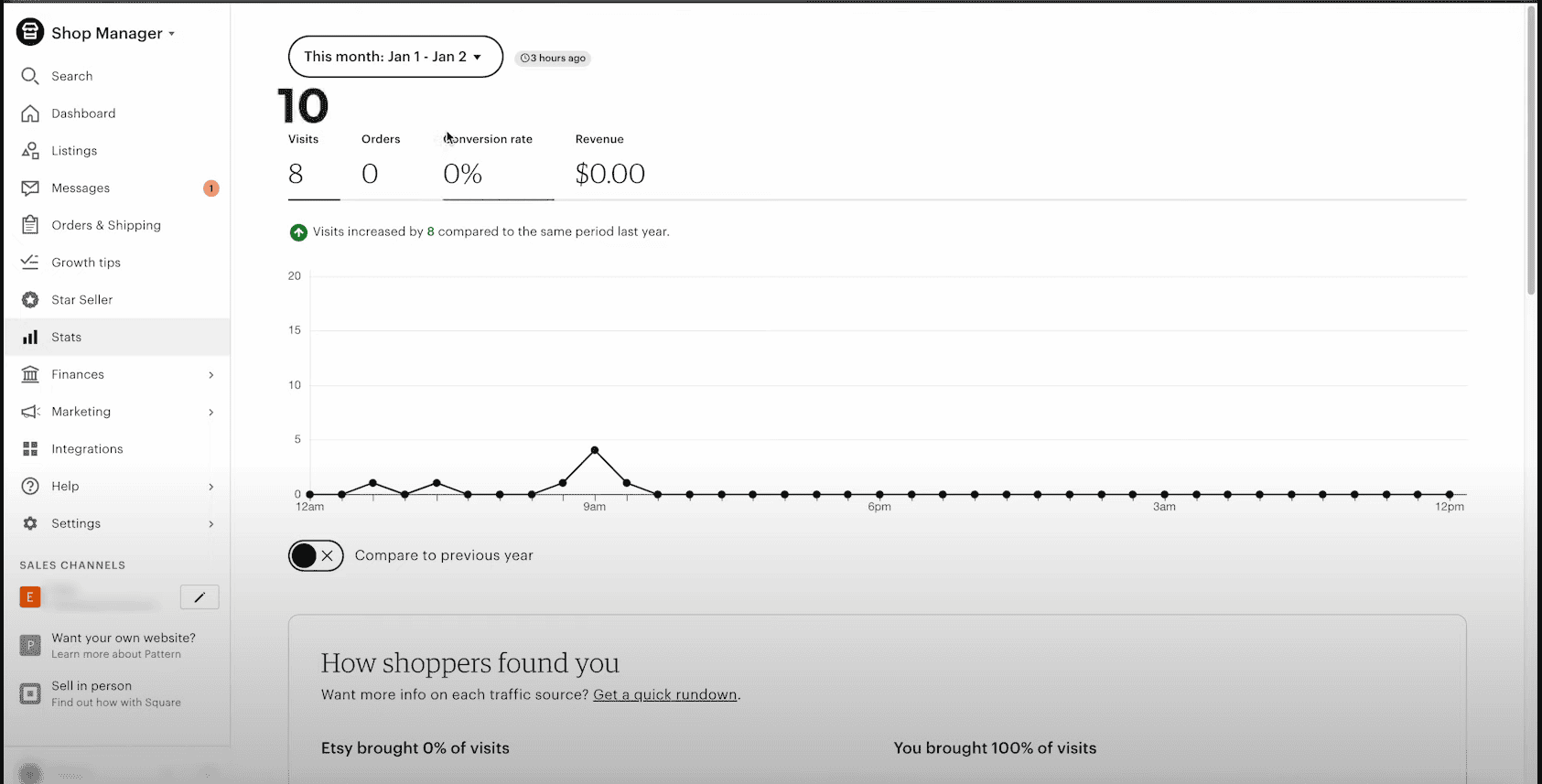
As an Etsy seller, keeping tabs on your shop’s performance metrics is crucial for growing your sales.
Luckily, the Etsy shop manager provides a dedicated Stats section that breaks down all the key data points you need.
Here’s a quick rundown of how to access those insights and what to watch:
Accessing Etsy Stats
To pull up your latest stats dashboard, just log into your account and go to Etsy Shop Manager > Stats. Simple as that!
The Main Metrics Overview
- Visits – How many people landed on your listings or storefront in total?
- Orders – Total sales completed within the period.
- Conversion Rate – Percentage of visitors who completed a purchase.
- Revenue – Your earnings after accounting for expenses like shipping/taxes.
You can also compare the current period metrics to the same span from the previous year if you’ve been operating that long.
Visits vs Views
While they may sound alike, these two metrics measure different things:
- Visits= Number of unique people who checked out your listings/storefront
- Views= Total times your listings were viewed (including multiple views by the same person)
How shoppers found you
This insightful breakdown shows exactly where your shop traffic originated from within the selected time period.
The main traffic source buckets are:
- Etsy – Visitors coming from Etsy’s search, app, browse pages, marketing, and more.
- You – Visitors you drove through efforts like social media, paid ads, and your marketing channels.
By keeping a close eye on your Etsy shop manager dashboard, you can quickly identify trends, drop-offs, and opportunities to optimize your listings and marketing. The intel is all there – it’s up to you to apply those insights and keep growing!
The shortcomings of Etsy’s native analytics
While shop manager on Etsy is a great starting point for tracking your store’s performance.
It does have some notable limitations that could leave you flying a bit blind when it comes to growth opportunities.
If you’re looking to level up your sales strategy, here are some key areas where Etsy’s native analytics may fall short:
Basic top-line metrics only
The data Etsy provides covers just the fundamental basics like visits, orders, revenue, and conversion rate.
While those high-level numbers are definitely important, there’s not much under-the-hood detail.
Trying to glean deeper insights into your marketing sources, customer journeys, acquisition funnels and more? You’ll quickly hit a wall.
Little-to-no segmentation
Etsy’s analytics has a pretty limited ability to segment and break out your data in meaningful ways.
That means no separating new buyers from loyal returners, no way to isolate your biggest spenders, and no meaningful segments to strategize around.
You’re forced to take a one-size-fits-all view.
Shop performance only, not customer behavior
The data is all very shop-centric in providing a bird’s eye view of visits, views, orders, and more.
But there’s no window into the actual behavior patterns of your customers. No visibility into their paths, their preferences, or their long-term lifetime value. Just topline performance stats.
Confined to the Etsy ecosystem
Of course, Etsy can only show you what’s happening within their platform’s walls.
Any efforts you have running on outside channels like your own website, social media, email newsletters, and more are invisible within these analytics.
You’d need separate tools to see the whole picture.
Zero demographic insights
There’s absolutely no way to glean any demographic data about who your customers actually are – their ages, genders, locations, income levels, and more.
And having that type of intel is critical for any sort of psychographic marketing, persona development, and product/range decisions. Etsy might leave you totally in the dark.
Don’t get me wrong, Etsy’s analytics are super handy for keeping track of the core vital signs of your shop’s performance.
But if you’re running any sort of multi-channel operation or want more powerful data to inform your business decisions, it likely won’t be enough.
Take your business further with Putler: Better e-commerce data beyond Etsy
As we covered, Etsy’s built-in analytics are a good starter package but lack the depth and multi-channel visibility to really supercharge your data-driven strategy.
That’s where tapping into a dedicated eCommerce analytics solution like Putler can be a game-changer.
Here are just some of the ways Putler takes your intel to the next level.
Etsy segmentation
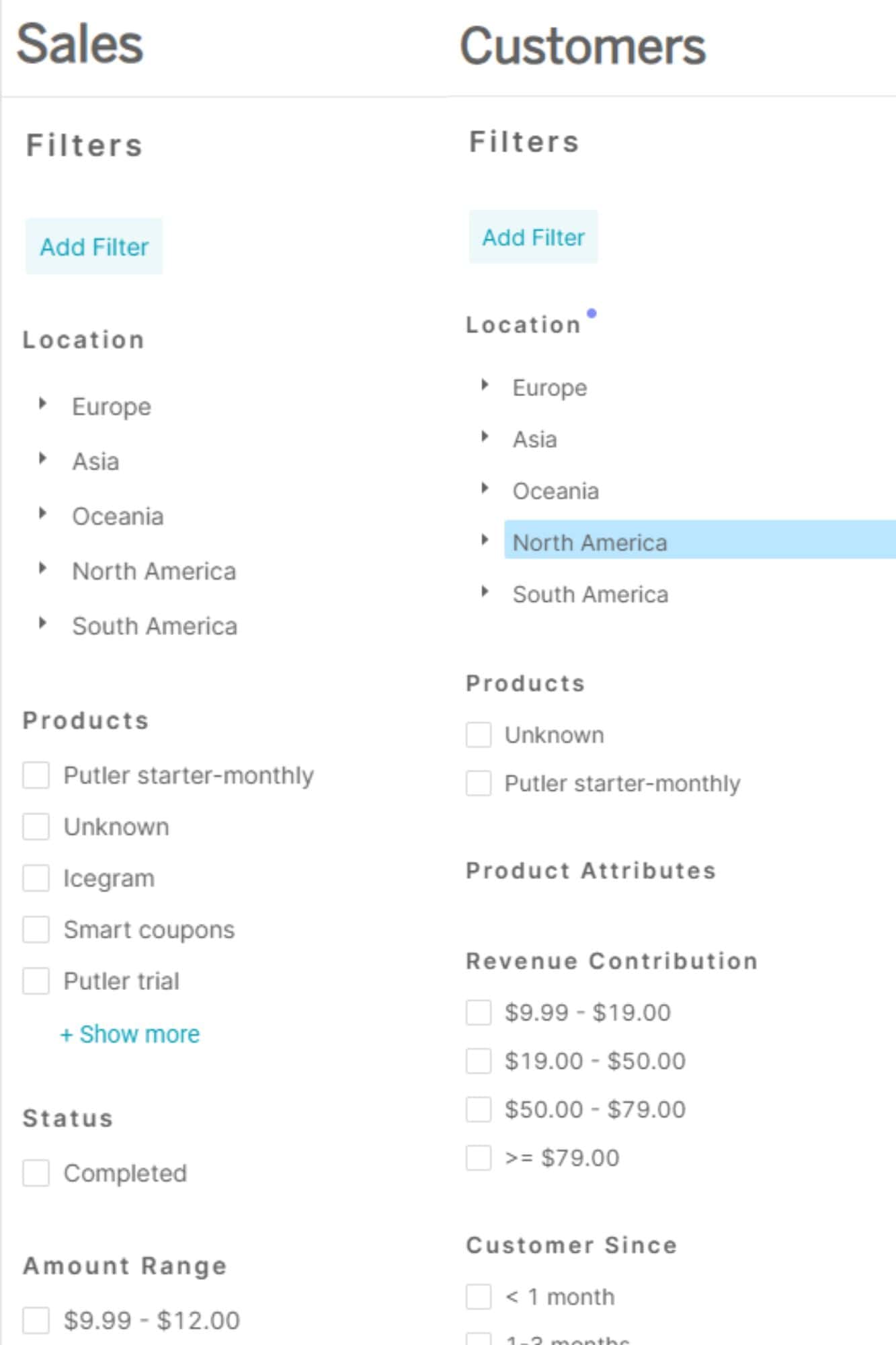
One of the biggest shortcomings of Etsy’s analytics is the lack of meaningful segmentation.
Putler makes it easy to use advanced filters to analyze and group your audience in many different ways– by location, purchase behavior, customer type, you name it.
Having that segmentation power allows you to execute super-targeted campaigns and strategies for different buyer personas.
Individual customer 360° view
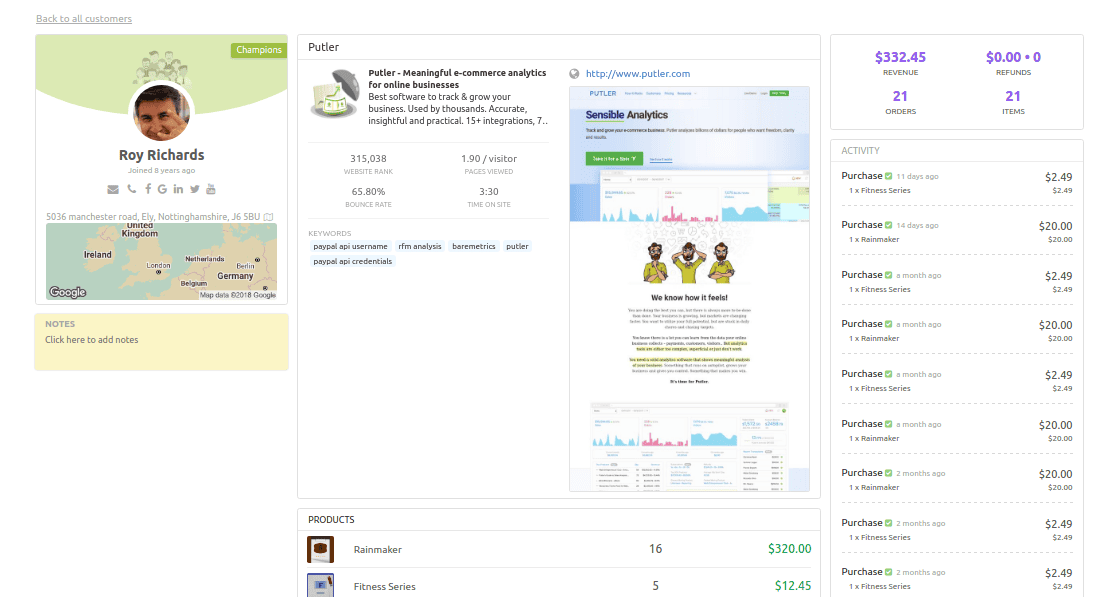
While Etsy’s stats are confined to just topline shop performance, Putler zooms in with detailed individual customer tracking.
Things like real-time activity logs, purchase journeys, failed transactions, location, emails, and phone numbers – a comprehensive timeline of each buyer’s behavior.
Those 360° profiles enable far more personalized customer relationships.
Multiple Etsy stores
It doesn’t matter if you have multiple Etsy stores or you want to expand to other eCommerce platforms.
Putler will collect data from all sources and give you a full view of your business.
Putler offers seamless integration across 17+ revenue channels, giving you a complete view of your business performance.
Connect popular eCommerce platforms like Shopify, WooCommerce, eBay, Amazon, and Etsy. Integrate payment processors like PayPal, Stripe, Authorize.net, and Braintree.
You can even link Google Analytics, email marketing tools like MailChimp, along with custom data sources. With Putler, all your data streams come together into one unified dashboard.
Rich demographic insights
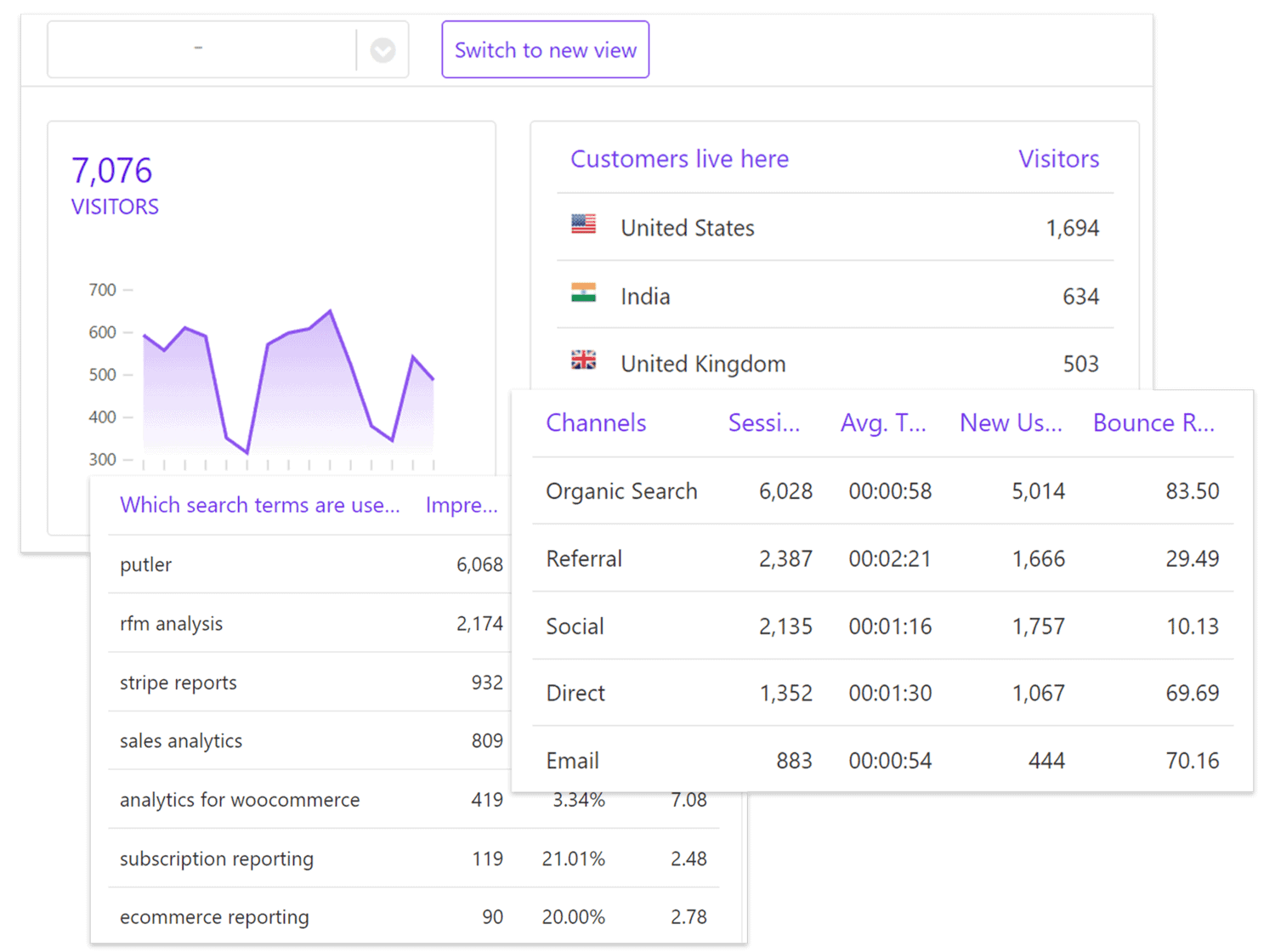
Know thy customer, right? Putler provides a wealth of demographic and psychographic data around your audiences that Etsy simply can’t match.
Locations, traffic sources, device data, social affinities – all the fine-grained targeting details to truly understand and segment your customers.
RFM segmentation
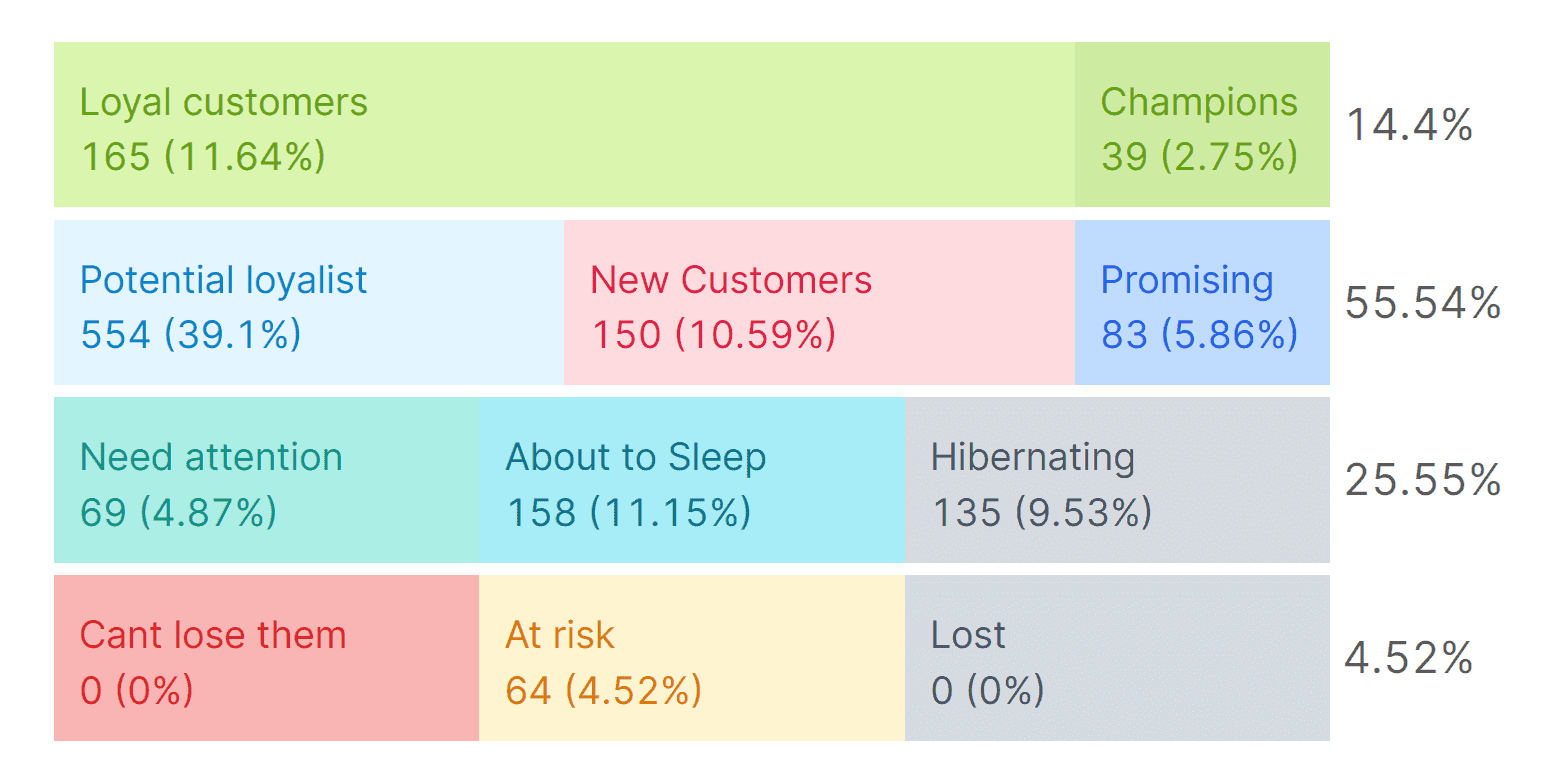
Putler’s RFM (Recency, Frequency, Monetary) analysis lets you segment customers based on their purchasing behaviors and patterns.
This shines a light on who your most valuable buyers are for focused upsell campaigns, as well as those at risk of churning so you can launch win back flows.
It’s a strategic way to maximize customer LTV and retention.
Sales heatmap
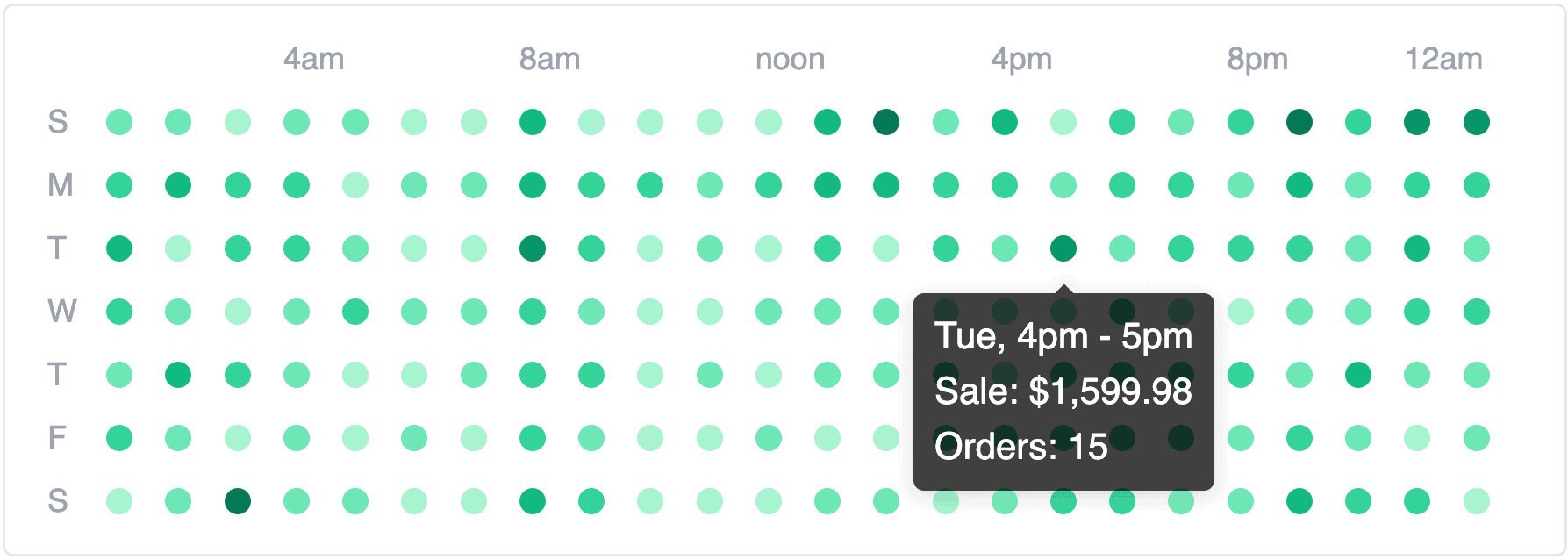
Want to know when your customers are most actively shopping and converting?
Putler’s Sales Heatmap visualizes your peak conversion windows.
You can then strategically time your promotions, discounts and marketing hits to align with those hot periods for maximum impact.
Upsell/Bundle opportunities
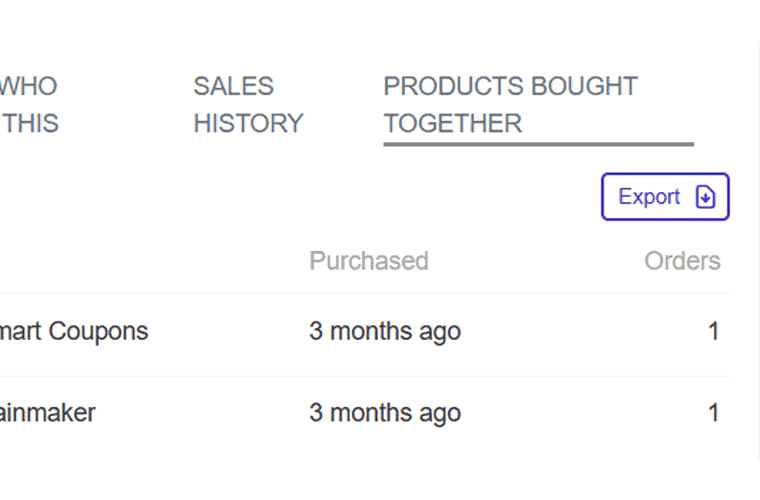
Within the Products dashboard, Putler analyzes which items customers frequently buy together so you can identify prime upsell and bundle opportunities.
A few simple product bundles can provide an easy lift to your average order values.
Multi-currency support
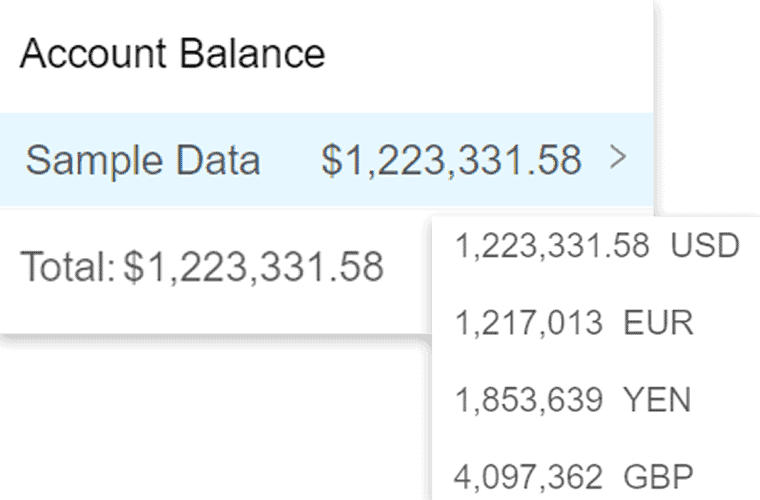
For Etsy sellers operating globally, Putler supports 36+ currencies out of the box.
That means accurate and consistent sales data across all your regional markets without having to do manual conversions. It streamlines your financial reporting.
Dedicated performance dashboards
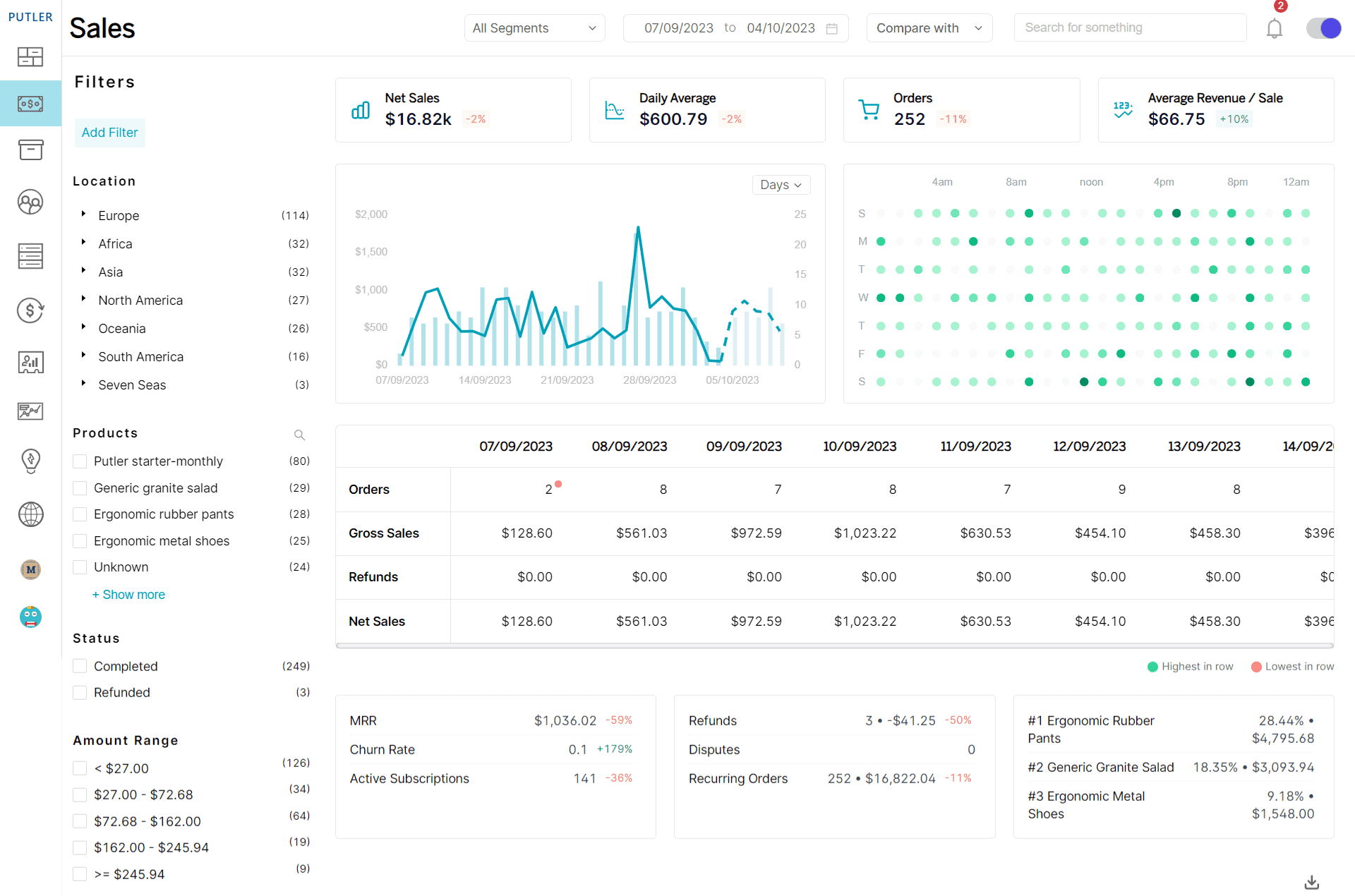
Rather than clunky reporting interfaces, Putler delivers intuitive dashboards purpose-built for analytics into every facet of your business.
Revenue forecasting

The Revenue Forecasting model assists in predicting the monthly revenue for each business for the upcoming year.
It takes into account the current revenue, its growth, and any potential reductions.
This information provides businesses with actionable insights into their future finances, enabling them to plan more effectively.
The level of insight Putler provides simply blows away Etsy’s limited data scope.
It’s analytics built for serious multi-channel sellers looking to gain a true competitive advantage through a smarter data-driven strategy.
Wrapping up
We’ve covered the ins and outs of the Etsy dashboard, highlighting its key features and how to make the most of them.
Whether you’re checking stats, managing listings, or engaging with customers, these tools are designed to help you run your shop smoothly and efficiently.
And for those looking to go beyond the basics, integrating with tools like Putler can provide deeper insights and greater control over your business strategy.
